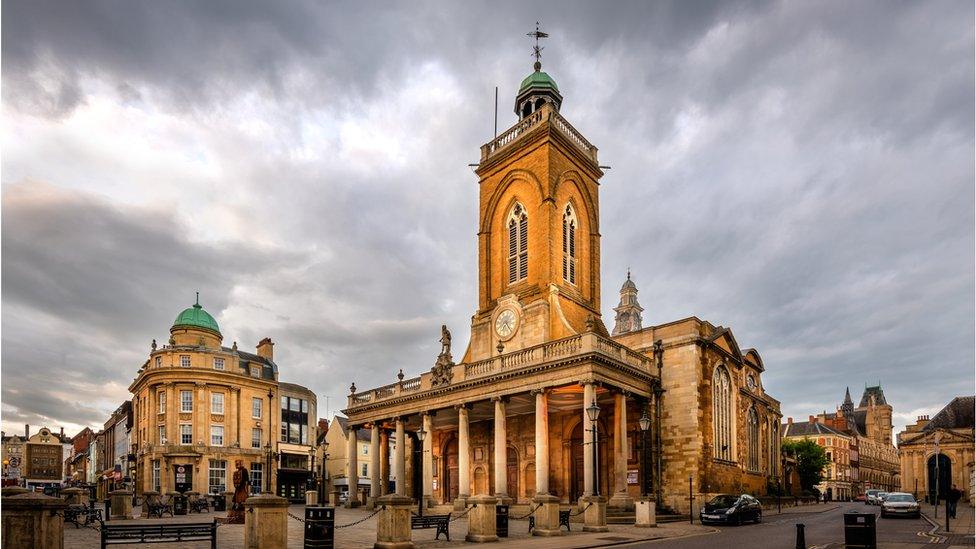Northampton: The ancient English university killed by a king
- Published

England's ancient universities: Oxford, Cambridge and... Northampton
Of the record numbers of university places offered to students this year, a few thousand were for "Oxbridge", that oft-used amalgam for the universities of Cambridge and Oxford. But were it not for a king's letter, it could all have been very different.
"How disappointed I was when I was told that even here (in England) the liberal arts were mute and Aristotle and Plato were forgotten in favour of Smith versus Jones," moaned the 13th Century philosopher and astronomer Daniel of Morley.
"But then," he went on, "I heard that such studies were flourishing in Northampton, and, not wanting to be the only Greek among Romans, I set out for that town."
Morley was not alone. Both the grammarian Geoffrey of Vinsauf and the Lombard Roger Vacarius also chose Northampton as their base instead of Oxford.
And yet, just four years after gaining its university charter in 1261, the Northampton University was no more.

Oxford proved useful to Henry III, who said he was revoking Northampton's charter to protect the future of learning in Oxford
To this day, the Northampton University remains the only institution in the UK ever to have been stripped of its university status.
The task of piecing together the history of this little-known bastion of ancient learning has fallen to Dr Cathy Smith, deputy dean of the faculty of education and humanities at the present day Northampton University, which was refounded in 2005.
"While there's very little information out there about the medieval Northampton University, we do know that Northampton was a really strong centre of scholarly activity at this time," says Dr Smith.
"This centre, which included a strong Jewish learning community, was formalised in 1261 with the university charter.
"A group of scholars left Cambridge and Oxford and were granted places to stay in Northampton."

Northampton once rivalled Oxford and Cambridge as a centre of learning
Anyone imagining a series of submerged dreaming spires beneath modern day Northampton will be disappointed, says Dr Smith.
Medieval universities did not look or function like their modern counterparts.
Medieval academics earned their money directly from their students who were taught, not in giant lecture halls, but in intimate rooms either within their own lodgings or in meeting houses.
With the exceptions of University College and St Edmund Hall - both in Oxford - the colleges that now dominate the hearts of Oxford and Cambridge had not been built when Northampton received its university charter.
As for Cambridge, the academics there would have to wait nearly two decades until after Northampton's demise to get their first college, Peterhouse, in 1284.
Although we have no idea of the location or population numbers of the medieval Northampton University, we do know a little of its curriculum.
"The academics at Northampton all came from slightly different backgrounds," says Dr Smith. "And while the teaching included law, like at Oxford and Cambridge, it was also broader than that and stretched into the humanities.
"It was that diversity, I think, which made Oxford feel slightly threatened."

Had the medieval University of Northampton survived, would they have an automatic place in the annual varsity boat race?
Hang on a second - Oxford, threatened? Well, Northampton had a lot going for it, says Dr Smith.
It was perfectly placed geographically along medieval travel routes. It was in a "religiously vibrant area with various abbeys nearby", meaning good business for academics teaching canon law, and, as mentioned above, it had a broad spectrum of academics.
But the fledgling university's fate was perhaps sealed when it chose the wrong side in a civil war.
In 1264, King Henry III fought and won a major battle against his rebellious barons at Northampton. During the siege, scholars there resisted the king's forces.
Less than a year later, the burgesses of Northampton received a message from the king, external.
It read: "We acceded to their request [to establish a university in 1261] because we believed then that this would benefit your town and that advantage would accrue to us; but now we have learned on the testimony of men worthy of belief that, if the university remains at Northampton, no small damage would be incurred by our borough of Oxford, which is of ancient creation, confirmed by our ancestors, and is generally approved as a convenience to students.
"We should on no grounds be willing that this should happen, especially as all the bishops agree that for the honour of God, the advantage of the Church of England and the well-being of the students, the university should be removed from Northampton."

Ancient university challenge

The oldest existing university is the University of al-Qarawiyyin in Morocco, founded in 859 AD
Europe's oldest university is the University of Bologna in Italy, founded in 1088
The University of Oxford is the oldest university in the English speaking world. There is no clear foundation date, but in 1231 the masters were recognised as a 'universitas', or corporation

Dr Smith believes Oxford, where the king had based his military operations, might have played a puppeteers' role in Northampton's demise.
As for that other place, Cambridge, well that was "really a bit of a non-starter", says Dr Smith, who doubts whether it would have survived had it not been for the Bishop of Ely Hugh de Balsham, who founded and endowed Peterhouse.
Cambridge University, founded in 1209 and established by a group of scholars who left Oxford after a dispute with townspeople, was still in its infancy by the mid 13th Century. During Northampton's heyday, international scholars such as Roger Vacarius might be enticed to Oxford and Northampton rather than Cambridge.
Were it not for King Henry III's charter withdrawal, says Dr Smith, Cambridge was the most likely medieval university to bite the dust.
That we now speak of "Oxbridge" rather than "Northbridge", "Oxton" or, dare we say it, just "Northampton", is largely down to the "accidental circumstances of history", she says.
"And just imagine what it would have meant for the boat race. It would have been a three-way race."
- Published18 August 2016
